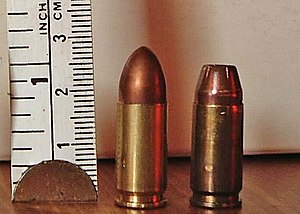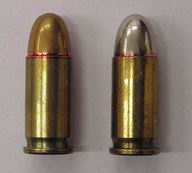Next week's show will be recorded and broadcast live! You can join us at:
http://www.blogtalkradio.com/personalarmament
Listen live on Tuesday at 10pm Central and join us in the chat room or call in!
Call 660-207-1239 and leave you questions, comments, or concerns on the voicemail or email: personalarmament@gmail.com
Right click and save link as... to download .mp3
(1:13:21)
We begin by answering some listener questions:
Question #1 from Bob:
My biggest problem in the reloading process is the powder measure. The Lee measure I have is junk and I don't trust it. Loads measured with Lee spoons need to be checked repeatedly, especially when loading something like 38 Specials when a tenth of a grain is important. Lately I've been filling a Lee spoon, dumping it into a tray on my digital scale and trickling powder until I hit the correct weight. Does anyone sell anything that's reliable for under $100 that will speed up the process?
James agrees with Bob that the Lee powder measure needs replacement and recommends the RCBS Uniflow or if you only load for pistols, the Little Dandy.
Dan points out that most scales don't even guarantee accuracy to the 1/10th of a grain. It is normally +/- 1/10th of a grain.
James adds that even though Redding and RCBS powder measures are both green, they operate differently. Remember that the Redding charges on the upstroke while the RCBS charges on the downstroke.
Dan points out that most scales don't even guarantee accuracy to the 1/10th of a grain. It is normally +/- 1/10th of a grain.
James adds that even though Redding and RCBS powder measures are both green, they operate differently. Remember that the Redding charges on the upstroke while the RCBS charges on the downstroke.
James the cheapskate recommends using a cartridge case instead of a powder trickler.
Dan adds that it is a good practice to weigh charges every few throws(~10) to verify that it is staying consistent.
Question #2 from Dave:
I Noticed that Lee has no Factory Crimp Die for this round. Is a crimp necessary? I am looking to buy a 6.5 Carcano rifle, but want to make sure I will be able to reload the ammo.
I have a Lee Classic Turret Press and so far have only reloaded .40 S&W and 9mm. Also wondering about getting a bullet mold for this. It does not look like a common mold?
Thanks! Your podcast has helped me tremendously with the reloading!
Rob has trouble pronouncing the cartridge, but James says that most of these Italian rifles are in great condition: Never been fired, only dropped once ;) Seriously though, it was a 6.5 Carcano that shot Kennedy.
James says that a crimp is not necessary and he rarely crimps unless it is a handgun cartridge more powerful than .357 Magnum or a big game cartridge bigger than .375 Magnum. This is to keep the bullets from backing out because of the recoil. If you don't have a cannelure or crimp groove, don't crimp. You will end up deforming the bearing surface. That deformation will cause inconsistencies and widen your group.
For the mold, James recommends Mountainmolds.com for a custom mold. An aluminum mold runs about $90. Molds can be made from aluminum, brass, or steel. They will even make custom top punches for your lubrisizer.
James goes into detail about how to create your custom mold and .
Question #3 from Derrek:
I have been loading handgun cartridges for about 2 yrs and I am about to buy my first new rifle. I thought I knew what I wanted, then the internet started to make me question my decision.
What I thought I wanted was a Remington 700SPS 308 with the 20" barrel. My "do-all" rifle. Primary use would be hunting deer in northern MI where a 125 yd shot would be the max for the area that I hunt. BUT, that doesn't mean I don't want to show off a little at the range either, out to 200 yds. Someone once told me that a .29 sectional density at about 2300-2500fps is the "magic" formula for taking deer size game. I don't know how he came to that figure, but I don't have any reason to doubt him. According to my manuals, all the bullets that are capeable of that SD and velocity are 200 gr and heavier. According to a couple other sites, the 1:12 twist rate of that rifle won't stabilize a bullet that heavy. That along with the notourious long throats of the 700 (that I may not be able to load the magazine with ideal OAL cartridges) has me wondering if I would just be better off starting with an entirely different platform.Savage's Model 11FCNS uses a 22" barrel which should be better as far as velocities, and a 1:10 twist which should give me more bullet choices.
Dan believes Derrek is on track with the .308 cartridge for the uses he mentioned. He also recommends Savage products when looking for a platform. We then launch into an all-out Savage love fest.
Cartridge Cases
Most casings are made from brass, steel, or aluminum. James and Dan have seen cases with plastic hulls and brass heads.
We start to list and go through the names of the parts of the case.
First we begin with the primer pocked and flash hole and James complains about Berdan primers.
Next, we move on to discuss the different types of rims:
These types are rimmed, rimless, semi-rimmed, rebated rim, and belted. These categories describe the size of the rim in relation to the base of the case.
Rimmed:
Examples of rimmed handgun cartridges include the .38 Special, .357 Magnum, .44 Magnum, etc. Rimmed rifle cartridge examples include the .22 Hornet, .303 British, 7.62x54mmR, and more.
Rimless:
On a rimless case, the rim is the same diameter as the base of the case; it is known as an extractor groove.
Examples of rimless handgun cartridges include the 9 mm Para, .40 S&W, and .45 ACP. Rimless rifle examples include the .308 Winchester, .223 Remington, and .30-06 Springfield.
Semi-Rimmed:
The .25 ACP, .32 ACP, .38 ACP and the .38 Super are some handgun examples, while the .444 Marlin is a rifle cartridge that is semi-rimmed.
Rebated Rim:
Rebated rim cartridges have a rim that is significantly smaller in diameter than the base of the case, serving only for extraction.
Belted:
After the rim comes the extractor groove, the web, and the case body. Next, we discuss the Wetherby shoulder vs. the sharper angled regular case shoulder.
Rob starts complaining about the incorrect anatomical references in case nomenclature.
Call 660-207-1239 and leave you questions, comments, or concerns on the voicemail or email: personalarmament@gmail.com
Right click and save link as... to download .mp3
(1:13:21)






No comments:
Post a Comment